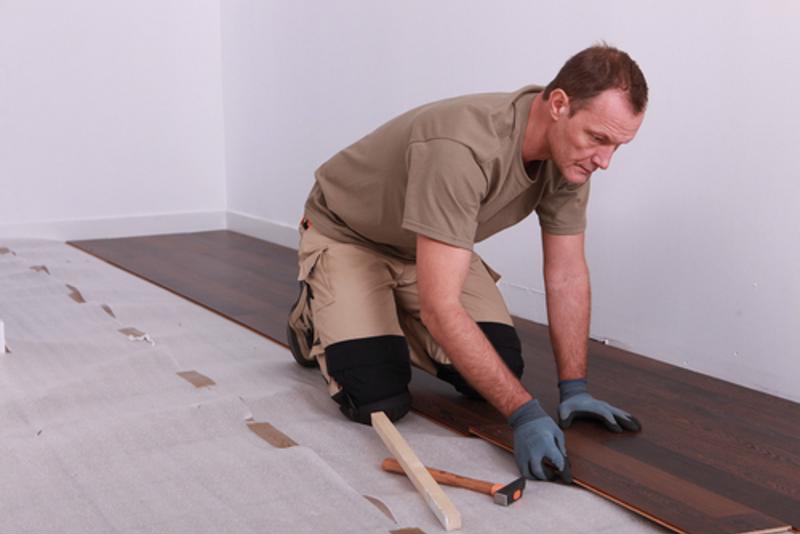Vinyl Flooring Underlayment
You’ve got your gloves on, your paint covered overalls ready to go and your boots laced tight – you’re almost ready for installing your own vinyl flooring. But before you can stand back and admire your new kitchen or bathroom floor, there’s a thing or two you need to know about the installation process that will provide your floors with a smoother finish and more stable surface.

Flooring underlayment is essential for a range of surfaces, including many vinyl flooring options (please note thinner vinyl flooring styles aren’t usually compatible with underlay). Absorbing the sounds of people walking over it and enhanced comfort underfoot are is just a couple of the advantages of having flooring underlayment. It will also do wonders for a flooring surface’s longevity and durability. For anyone considering a DIY approach to vinyl flooring installation, here’s what you need to know about underlay:
What is underlayment?
The installment of floors requires at least a few layers, sometimes as many as four. Here is a breakdown of the four primary layers that account for most floors:

- Joists: The first layer, which is the wooden foundation underneath the floor.
- Subfloor: Usually already intact; generally plywood, which provides support for everything.
- Underlayment: Rolls of plywood, fiberboards or other rolls of material that serve as a buffer between the subfloor and the surface, improving stability.
- Finish floor: The actual materials you see and walk on, such as tile or stone.
Essentially, underlayment is installed to make sure that any subtle mistakes or discrepancies made within the subfloor layer will not become an issue. Underlayment also plays a big role in the acoustic performance of your floor.
Why you need vinyl flooring underlayment
There are three primary reasons why vinyl flooring owners should have underlayment installed beneath the surface: To allow for a smoother exterior along the finish floor, to provide added stability and protection, and to enhance the acoustic capabilities of the floor. Installing underlayment is how you can add compression resistance to your floor, which will vastly reduce wear and tear after years of traffic in your house. It also helps guard against moisture. Finally, luxury vinyl flooring underlayment is the best way to get the most out of your floor acoustically, as sounds will be absorbed, minimizing the echoes of footsteps.
“Vinyl flooring underlayment is the best way to get the most out of your floor acoustically.”Does vinyl flooring need underlayment?
If you’re trying to increase some height to your floor, then adding an underlayment under the finish floor can be useful. If you’re unsure whether installing underlayment for your vinyl flooring project is truly necessary, then talk to knowledgeable BuildDirect product expert or a professional installer to see if your existing subfloor is already suitable enough to have the finish floor covering it.





Jeffrey Scopinich
Want to install vinyl tile onto kitchen floor. It is a pine subfloor with paint on it. Can I glue tiles directly to it? If not what are my options. Don’t want to increase floor ,height as there are built in radiator covers that wont allow for much additional height.
Bryan G
What would be the best underlayment for this over a OSB Sub Floor?
2mm Mount Craig Cherry Luxury Vinyl Plank (LVP) Flooring- 6″ W x 36″ L Peel and Stick Plank
Doing 810 Sq. Ft and only want to do it once.
BuildDirect Product Expert Team
Hi Bryan,
Most peel and stick floors will not allow an underlay beneath. You will need to check the specific installation instructions for the floor you have. You may be able to find a glue down option that does allow for peel and stick floor at your local hardware store. Please let us know if you have any other questions!
Wanda Garcia
I’m interested in the Siberian Elm Vinyl Plank flooring. It has a cork back and it is 9.5 thick. Do I need an underlayment?
BuildDirect Product Expert Team
Hi Wanda,
Thank you for your inquiry! If you are installing over concrete you will need at least a basic vapor barrier beneath the planks. If you are installing over plywood then you can lay the plank right on the sub floor. I have included a link to an example of vapor barrier that we carry below:
https://www.builddirect.com/p/MoistureBlock-Vapor-Barrier–10076337
Please let us know if you have any other questions!
Maria Aulia
Hello,
I live on 2nd floor Condominiums and planning to replace my carpet with LVP due to allergies.
HOA states no hard surface for flooring but does not mention alternative for carpets.
Do you have IIC ratings for the underlayment+LVP when installed together? How is it compared to carpet?
I am trying to avoid complains from neighbor downstairs that could lead to litigation if they see I do not have carpet.
BuildDirect Product Expert Team
Hi Maria,
Thank you for your inquiry! We don’t have IIC ratings for the combined floor and underlay but each underlay option we have has their IIC rating. It can usually be found in the features, specifications or installation guide. I’ve included the links to our two LVT underlay options with the highest IIC ratings below:
https://www.builddirect.com/Underlay/High-Density-LVT-Glueable-Foam-Underlayment—100-sq-ft-Roll/ProductDisplay_10575_p1_10104964.aspx
https://www.builddirect.com/Underlay/1.5mm-Luxury-Vinyl-Underlayment—100-Sq-Ft-Roll/ProductDisplay_10575_p1_15000565.aspx
Please let us know if you have any other questions!
SALVATORE SAVA
i just purchased Adura luxury vinyl plank floors and it was never mentioned to me about having underlayment ? i believe i was told the rooms were 576sq ft. is there a particular one i should be getting.
BuildDirect Product Expert Team
Hi Salvatore,
Thank you for getting in touch! You will need to check the warranty of the vinyl you purchased but most of the time you will only need a basic vapor barrier beneath vinyl if you are installing over a concrete subfloor. If you are installing over a plywood subfloor you can lay the vinyl right on top. In either case I still recommend an underlay because vinyl is a thinner products and an underlay with help with sound absorption as well as temperature insulation, especially over concrete. Please let us know if you have any other questions!
Beth
I am getting ready to install new vinyl plank flooring over concrete slab. I have bought 1.5 mm flooring underlayment specifically used as underlayment for vinyl floating floors. I am concerned about the amount of insulation this will give me and wondering if I would be better off ditching the 1.5 mm underlayment and installing a wood subfloor such as the interlocking product called Dricor instead.
Your thoughts are much appreciated!
Thank you!
Karen McConnell
I’m going to be installing click type luxury vinyl planks .5 mm & want to add an underlayment. Any suggestions on type to use? I’ve been comparing a felt type & cork.